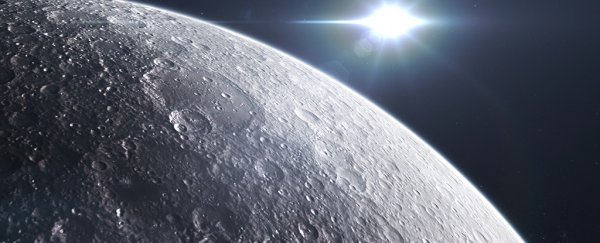When it comes to knowing what kinds of minerals we might find inside the Moon, we've literally just scraped the surface. For one small team of Earth scientists from the US and Canada, that's enough to suggest there's treasure hiding deep below.
Mining for riches is the last thing that's on the researchers' minds, though. By knowing more about lunar chemistry, they might be able to resolve a conflict over an apparent shortfall in precious elements thought to make up the Moon's mantle.
While we've been staring up at half of the Moon's face since forever, we only received our first real clues on what lies beneath its surface when astronauts brought back several hundred kilograms of lunar material about half a century ago.
"We have a grand total of 400 kilograms of sample that was brought back by the Apollo and lunar missions… it's a pretty small amount of material," says Earth scientist James Brenan from Dalhousie University in Canada.
"So, in order to find out anything about the interior of the Moon we have to kind of reverse engineer the composition of the lavas that come onto the surface."
One bit of retro-engineering on basalts brought back from the Apollo 15 and 17 missions was used back in 2007 to estimate the amount of siderophile, or 'iron-loving', elements making up the Moon's mantle.
A good proportion of these should have come from a rain of left-over building materials as the Solar System wound up its construction phase, so it's a handy indicator of the kind of assault the Moon endured soon after it formed.
Strangely, the measurements were 10 to 100 times lower than expected.
Even after applying models adjusting the way meteorite impacts might erode the Moon rather than contribute to its mass, the numbers never quite made sense, leaving plenty of room for questions.
Part of the problem could be in how researchers often start with an assumption that the Moon's geochemistry is more or less the same as our own.
It's not exactly an unreasonable assumption to make, given widely-held theories suggest the Moon was made from our planet's own flesh and bones.
But for all of their similarities, there are enough differences to make it worthwhile going back to basics.
So the team of scientists combined the results of experiments on the solubility of sulphur with models on the pressure and thermodynamics of cooling magma to pin down a more accurate set of constraints on the makeup of the lunar mantle.
They found those missing siderophile elements were more than likely up there. They just hadn't been squeezed out onto the surface.
"Our results show that sulphur in lunar volcanic rocks is a fingerprint for the presence of iron sulphide in the rocky interior of the moon, which is where we think the precious metals were left behind when the lavas were created," says Brenan.
While the results don't provide a solid estimate on the composition of precious metals in the mantle, they're enough to make it clear we can't rely on existing rock samples to come to any solid conclusions either.
Before you book your place next to Jeff Bezos on the first tourist lunar lander out of town, you should know these metals probably won't be found as concentrations of ore ripe for easy picking.
Whether they're worth mining at all in the future will depend on what future missions find, and whether the economics make sense.
Explorations of deep rock formations exposed by impacts over the Moon's southern regions could help constrain figures on iron-loving elements in the mantle even further.
"It's pretty exciting to think that we might return to the Moon," says Brenan.
"And if so, the South Pole seems like a good choice for sampling."
This research was published in Nature Geoscience.
